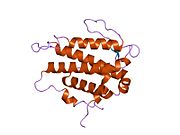MOBKL1A
(Redirected from MOB1B)
An Error has occurred retrieving Wikidata item for infobox Mps one binder kinase activator-like 1A, also known as Mob1 homolog 1A, is a protein that in humans is encoded by the MOBKL1A gene.[1][2]
Function
The protein encoded by this gene is similar to the yeast Mob1 protein. Yeast Mob1 binds Mps1p, a protein kinase essential for spindle pole body duplication and mitotic checkpoint regulation.[1]
See also
References
- ^ 1.0 1.1 "Entrez Gene: MOB1".
- ^ Devroe E, Erdjument-Bromage H, Tempst P, Silver PA (June 2004). "Human Mob proteins regulate the NDR1 and NDR2 serine-threonine kinases". J. Biol. Chem. 279 (23): 24444–51. doi:10.1074/jbc.M401999200. PMID 15067004.
Further reading
- Gerhard DS, Wagner L, Feingold EA, et al. (2004). "The status, quality, and expansion of the NIH full-length cDNA project: the Mammalian Gene Collection (MGC)". Genome Res. 14 (10B): 2121–7. doi:10.1101/gr.2596504. PMC 528928. PMID 15489334.
- Ota T, Suzuki Y, Nishikawa T, et al. (2004). "Complete sequencing and characterization of 21,243 full-length human cDNAs". Nat. Genet. 36 (1): 40–5. doi:10.1038/ng1285. PMID 14702039.
- Bonaldo MF, Lennon G, Soares MB (1996). "Normalization and subtraction: two approaches to facilitate gene discovery". Genome Res. 6 (9): 791–806. doi:10.1101/gr.6.9.791. PMID 8889548.
- Bichsel SJ, Tamaskovic R, Stegert MR, Hemmings BA (2004). "Mechanism of activation of NDR (nuclear Dbf2-related) protein kinase by the hMOB1 protein". J. Biol. Chem. 279 (34): 35228–35. doi:10.1074/jbc.M404542200. PMID 15197186.
- Strausberg RL, Feingold EA, Grouse LH, et al. (2002). "Generation and initial analysis of more than 15,000 full-length human and mouse cDNA sequences". Proc. Natl. Acad. Sci. U.S.A. 99 (26): 16899–903. Bibcode:2002PNAS...9916899M. doi:10.1073/pnas.242603899. PMC 139241. PMID 12477932.
- Chow A, Hao Y, Yang X (2010). "Molecular characterization of human homologs of yeast MOB1". Int. J. Cancer. 126 (9): 2079–89. doi:10.1002/ijc.24878. hdl:1974/1468. PMID 19739119. S2CID 33688672.
This article incorporates text from the United States National Library of Medicine, which is in the public domain.

